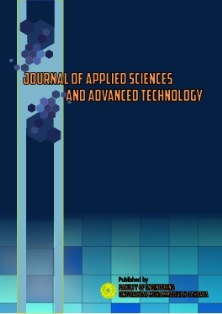Readiness of National Industries Infrastructure to Support the RDE Programme in Indonesia
DOI:
https://doi.org/10.24853/jasat.3.2.65-74Keywords:
Infrastructure, Industry, Readiness, RDEAbstract
Nuclear Power Plant (PLTN) is one of the options to meet electricity for society and industry. BATAN has developed an Experimental Power Reactor (RDE) design which is one type of Non-Commercial Power Reactor (RDE) is a HTGR (High Temperature Gas-cooled Reactor) NPP with 10 MWth Pebble Bed Reactor (PBR) technology, and is used for non-electric electricity. This reactor type can generate electricity and heat. The development of RDE in Indonesia requires 19 aspects of nuclear infrastructure. One aspect of them is the involvement of national industries. The RDE development is expected to involve several national industries that can participate in supplying government goods and services. The purpose of this research is to determine the capability and readiness of the national industrial infrastructure to be able to participate in the development of RDE in Indonesia. The methodology used is literature review, technical surveys or visits, and technical consultations with key persons from industries. The study results conclude that the civil construction industries and the EPC industries have the readiness and ability to be able to build RDE building especially for non-nuclear parts. The Architect Engineering have the potential and capability for the RDE project management, engineering and Design development. The mechanical industries have the potential and capability to produce turbines, generators, condensers and heat exchangers. The electrical industries have the potential and capability to supply electrical components for the electrical system, such as Switchgear, main transformers, distribution transformers, generators, conductors, power cables, connectors and electrical panels. The Instrumentation & Control industries have the potency and capability to supply I&C products such as instrumentation cable, instrumentation communication system, temperature controller, etc. The output expected from this research is the readiness of nuclear infrastructure, especially the national industries for the supply of non-nuclear components.Downloads
References
Presiden Negara Republik Indonesia, Undang-Undang Republik Indonesia Nomor 10 Tahun 1997 Tentang Ketenaganukliran. Jakarta: Menteri Negara Sekretariat Negara Republik Indonesia, 1997.
Presiden Negara Republik Indonesia, Peraturan Pemerintah Republik Indonesia Nomor 79 Tahun 2014 Tentang Kebijakan Energi nasional. Jakarta: Kementerian Hukum dan Hak Asasi Manusia Negara Republik Indonesia, 2014.
T. E. Hicks, D. Petti, J. C. Kinsey, and G. Gibbs, “Modular HTGR Safety Basis and Approach,” Idaho National Laboratory, no. August. Washington, DC, 2011.
S. Alimah, E. Dewita, and S. Ariyanto, “Analisis Komparasi HTGR Tipe Prismatik dan Pebble Bed,” J. Pengemb. Energi Nukl., vol. 16, no. Juni, pp. 11–21, 2014.
O. Sambuu and T. Obara, “Above-ground HTGR design for passive decay heat removal,” J. Nucl. Sci. Technol., vol. 52, no. 6, pp. 857–871, 2015.
A. M. Ougouag, H. D. Gougar, W. K. Terry, R. Mphahlele, and K. N. Ivanov, “Optimal moderation in the pebble-bed reactor for enhanced passive safety and improved fuel utilization,” in Proceedings of the PHYSOR 2004: The Physics of Fuel Cycles and Advanced Nuclear Systems - Global Developments, 2004.
D. Jianling, K. Xiangwei, S. Yingming, and Y. Yongwei, “Concept Design of Pebble Bed Based HTGR With Fast Pebble Discharge System,” React. Technol., pp. 1–7, 2004.
L. Zhang, F. Li, Y. Dong, and J. Qu, “A study on the standard system for HTGR power plants,” in 23rd Conference on Structural Mechanics in Reactor Technology, 2015, vol. 100.
C. F. McDonald, R. G. Adams, F. R. Bell, and P. Fortescue, “Component Design Considerations for Gas Turbine HTGR Power Plant,” ASME Publ., vol. December, no. 75-GT-67, pp. 1–17, 1975.
A. T. Yuliyanto et al., “Calculation of Domestic Raw Materials Using Domestic Resource Cost Method,” J. Phys. Conf. Ser., vol. 1198, no. 2, 2019.
A. C. Kadak, “The Status of the US High-Temperature Gas Reactors,” Engineering, vol. 2, no. 1, pp. 119–123, 2016.
NEA, “Technology Roadmap Update for Generation IV Nuclear Energy Systems,” 2014.
T. Setiadipura, J. S. Pane, and Zuhair, “Studi Awal Desain Pebble Bed Reactor Berbasis HTR-PM Dengan Resirkulasi Bahan Bakar Once-Through-Then-Out,” J. Pengemb. Energi Nukl., vol. 18, no. 1, pp. 59–65, 2016.
H. Ohashi et al., “A small-sized HTGR system design for multiple heat applications for developing countries,” Int. J. Nucl. Energy Sci. Technol., vol. 2013, pp. 1–18, 2013.
T. Taryo, I. Husnayani, R. M. Subekti, S. Sudadiyo, E. Saragi, and Rokhmadi, “The development of HTGR-TRISO coated fuels in the globe: Challenging of Indonesia to be an HTGR fuel producer,” J. Phys. Conf. Ser., vol. 1198, no. 2, pp. 1–16, 2019.
D. R. Saputra, Y. Yulianti, and A. Riyanto, “Studi Desain High Temperature Gas-Cooled Reactor (HTGR) Berpendingin Gas Hidrogen Menggunakan Bahan Bakar Thorium,” J. Teor. dan Apl. Fis., vol. 07, no. 01, pp. 99–106, 2019.
D. Armanita, D. Fitriyani, and T. Setiadipura, “Optimisasi Ukuran Teras High Temperature Gass-cooled Reactor (HTGR) dengan Daya 30 MWt Tipe Pebble Bed Berbasis Bahan Bakar Uranium,” J. Fis. Unand, vol. 9, no. 1, pp. 100–109, 2020.
B. J. Marsden, S. L. Fok, and G. Hall, “High temperature gas-cooled reactor core design future material consideration,” in International Conference on Global Environment and Advanced Nuclear Power Plants (GENES4/ANP2003), 2003, vol. l, no. 0, pp. 15–19.
P. Breeze, Power Generation Technology, 3rd ed. Chennai: Joe Hayton, 2019.
BATAN, “Rencana Pembangunan RDE di Indonesia,” Badan Tenaga Nuklir Nasional, 2018. [Online]. Available: http://www.batan.go.id/index.php/id/rencana-pembangunan-rde-di-indonesia. [Accessed: 01-May-2018].
A. T. Yuliyanto et al., “Studi Kesiapan Infrastruktur Industri Pendukung RDE,” Jakarta, 2018.
D. Dewi et al., “Studi Kesiapan Infrastuktur Industri Pendukung RDNK,” Badan Tenaga Nuklir Nasional Pusat Kajian Sistem Energi Nuklir, Jakarta, 2018.
IAEA, Industrial Involvement to Support a National Nuclear Programme, vol. NG-T, no. 3.4. Vienna: International Atomic Energy Agency Nuclear Energy Series, 2016.
H. A. Gohel, H. Upadhyay, L. Lagos, K. Cooper, and A. Sanzetenea, “Predictive maintenance architecture development for nuclear infrastructure using machine learning,” Nucl. Eng. Technol., vol. 52, no. 7, pp. 1436–1442, 2020.
T. Taryo et al., “Analysis of Fuel Temperature Increase Accident in RDE core,” J. Phys. Conf. Ser., vol. 1493, no. 1, 2020.
Presiden Negara Republik Indonesia, Peraturan Pemerintah Republik Indonesia Nomor 14 Tahun 2015 Tentang Rencana Induk Pembangunan Industri Nasional Tahun 2015-2035. Jakarta: Kementerian Hukum dan Hak Asasi Manusia Negara Republik Indonesia, 2015.
T. Setiadipura, S. Bakhri, G. R. Sunaryo, and D. S. Wisnusubroto, “Cooling passive safety features of Reaktor Daya Eksperimental,” in AIP Conference Proceedings, 2018, vol. 1984, pp. 1–9.
A. T. Yuliyanto, “Analisis Kontribusi Industri Indonesia Dalam Mendukung Pembangunan Pembangkit Listrik Tenaga Nuklir,” Universitas Indonesia, 2012.
Menteri Perindustrian Negara Republik Indonesia, Peraturan Menteri Perindustrian No 54 2012 Pedoman Penggunaan Produk Dalam Negeri Untuk Pembangunan Infrastruktur Ketenagalistrikan. Jakarta: Kementerian Hukum dan Hak Asasi Manusia Negara Republik Indonesia, 2012.
D. Dewi and Sriyana, “Studi Potensi Industri Jasa Konstruksi Untuk Mendukung Pembangunan Pembangkit Listrik Tenaga Nuklir Pertama Di Indonesia,” J. Pengemb. Energi Nukl., vol. 10, no. 1, pp. 31–40, 2008.
Pusat Studi Kebijakan Publik Universitas Gadjah Mada and Badan Tenaga Nuklir Nasional, “Studi Manajemen Proyek PLTN dan Penyiapan Sumber Daya Manusia,” Jakarta, 2006.
PT Barata Indonesia (Persero), “PT Barata Indonesia (Persero) Company Profile,” PT Barata Indonesia (Persero), 2020. [Online]. Available: https://www.barata.id/id/. [Accessed: 27-Dec-2020].
PT Boma Bisma Indra, “PT Boma Bisma Indra Company Profile,” PT Boma Bisma Indra, 2020. [Online]. Available: http://ptbbi.co.id/. [Accessed: 27-Dec-2020].
PT PAL Indonesia (Persero), “PT PAL Indonesia (Persero) Company Profile,” PT PAL Indonesia (Persero), 2020. [Online]. Available: https://pal.co.id/. [Accessed: 14-Dec-2020].
PT Pindad (Persero), “PT Pindad (Persero) Company Profile,” PT Pindad (Persero), 2020. [Online]. Available: https://www.pindad.com/home. [Accessed: 27-Dec-2020].
PT Nusantara Turbin dan Propulsi, “PT Nusantara Turbin dan Propulsi Company Profile,” PT Nusantara Turbin dan Propulsi, 2020. [Online]. Available: https://www.umcntp.co.id/. [Accessed: 27-Dec-2020].
PT Bambang Djaja, “PT Bambang Djaja Company Profile,” PT Bambang Djaja, 2020. [Online]. Available: https://bambangdjaja.com/. [Accessed: 27-Dec-2020].
Downloads
Published
Issue
Section
License
COPYRIGHT POLICY
The author(s) of an article published in the Journal of Applied Sciences and Advanced Technology (JASAT) retains ownership of the intellectual property rights in work (s).
PUBLISHING RIGHTS
The author(s) of an article published in the Journal of Applied Sciences and Advanced Technology (JASAT) have unrestricted publication rights. The authors give the Journal of Applied Sciences and Advanced Technology (JASAT) the right to publish the article and designate the Faculty of Engineering Universitas Muhammadiyah Jakarta Publishing as the original publisher of the article.
LICENSING POLICY
JASAT is an open-access journal that follows the Creative Commons Non-Commercial 4.0 International License (CC BY-NC 4.0), which states that:

Under this license, the reusers must give appropriate credit, provide a link to the license, and indicate if changes were made. Users may do so in any reasonable manner, but not in any way that suggests the licensor endorses users or their use.
Please take the time to read the whole license agreement (https://creativecommons.org/licenses/by-nc/4.0/). As long as reusers follow the license conditions, the owner cannot withdraw these freedoms. The following components are included under this license:
 Attribution: Users must provide appropriate attribution, including a link to the license, and indicate whether or not they made any modifications. Users are free to do so reasonably, but not in a manner that indicates the licensee approves of their usage.
Attribution: Users must provide appropriate attribution, including a link to the license, and indicate whether or not they made any modifications. Users are free to do so reasonably, but not in a manner that indicates the licensee approves of their usage.
 NonCommercial: Users may not use the material for commercial purposes.
NonCommercial: Users may not use the material for commercial purposes.












_2.png)


1.png)

2.png)
